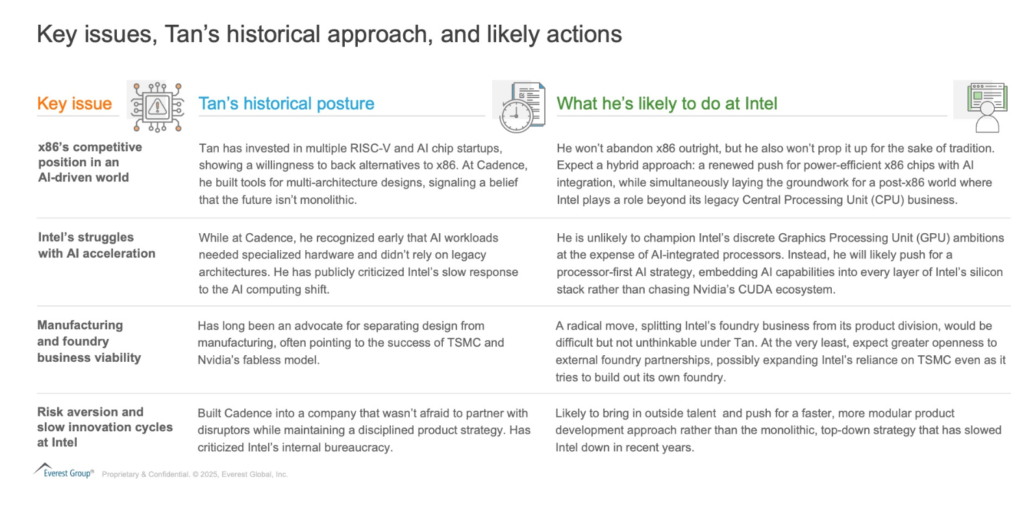
Lip-Bu Tan’s appointment as Intel’s Chief Executive Officer (CEO) comes at a pivotal moment, as the company faces existential questions about its role in the future of computing.
His track record as an investor in artificial intelligence (AI) startups and his tenure at Cadence Design Systems suggests that the Intel board was looking for a leader who could bring an outsider’s perspective, challenge the company’s legacy approach, and accelerate its shift toward AI-driven computing.
At the same time, his deep connections in the semiconductor ecosystem and experience balancing product innovation with financial discipline likely reassured the board that he could steer Intel toward long-term competitiveness without abandoning its core enterprise base.
Intel’s challenges are no longer just about execution but about strategic identity—whether it continues to shape the industry as it once did or becomes just another semiconductor company navigating a landscape dominated by AI-first computing.
Let’s look at these challenges and the thought processes that went Tan’s appointment as the new CEO.
Reach out to discuss this topic in depth.
Key issues, Tan’s historical approach, and likely actions

Impact on enterprise investments in existing Intel software and infrastructure
For enterprises deeply invested in x86-based software and infrastructure, the underlying question is not whether x86 will disappear, but how Intel will make it viable in an AI-driven world.
If Tan commits to reinventing x86 with power-efficient designs and AI acceleration, it could extend its relevance well into the next decade. Companies that have built their entire IT stacks on x86—spanning enterprise software, cloud workloads, and data center architectures—could see Intel return to form with more competitive processors.
However, there is an alternative scenario. If Tan decides that Intel’s future lies beyond x86, he may push resources toward AI accelerators and more modular compute architectures. This would be a more profound shift, signaling that Intel is hedging its bets and preparing for a future where enterprises mix and match compute architectures rather than defaulting to x86.
The most realistic outcome lies in the middle. Intel will likely modernize x86 with AI-first capabilities, making it more efficient for AI workloads, while also ramping up investments in accelerators and alternative compute architectures. This will buy time for enterprises to plan long-term transitions while keeping x86 viable in the short to mid-term.
Anticipated changes in enterprise AI strategy: Discrete GPUs or a shift toward processor-integrated AI acceleration?
Intel’s discrete GPU ambitions—especially in enterprise AI—have always felt like a reactionary move rather than a strategic conviction. The company arrived late to the game, competing against Nvidia’s deeply entrenched CUDA ecosystem and AMD’s aggressive push into AI GPUs.
Tan’s background suggests he is unlikely to double down on discrete GPUs at all costs. He understands that the real AI war is not just about GPUs, but about AI-first compute architectures. The companies that succeed in AI computing are those that embed AI capabilities across all their silicon, not just in a dedicated GPU line.
Intel has already been integrating AI acceleration into its CPUs. Under Tan, this strategy could become the primary focus. Instead of throwing more resources into chasing Nvidia, Intel may focus on embedding AI acceleration directly into CPUs and other processing units, offering enterprises a more integrated, scalable AI strategy without forcing them to rearchitect around GPUs.
That said, discrete GPUs won’t disappear entirely. Certain workloads will continue to demand dedicated AI processors, and Intel may still pursue this space. But the difference under Tan will be an emphasis on AI computing, rather than a myopic race to compete with Nvidia in the GPU market alone.
Changes enterprise IT buyers should expect in Intel’s server roadmap
The defining challenge for Intel’s server roadmap is that it is caught between two conflicting realities. On one hand, it must continue to serve the existing enterprise base that runs on x86. On the other, it must adapt to a world where AI-first computing and alternative architectures are becoming the norm.
Under Tan, enterprises should expect a more modular and AI-driven approach to Intel’s server strategy. This could mean:
- More hybrid compute models, where x86 remains, but AI acceleration plays a much larger role
- Faster product cycles, as Tan pushes for Intel to be more agile in responding to market demands
- Potential restructuring of Intel’s server division, possibly with a clearer separation between AI-first products and traditional x86 offerings
One big question is whether Tan will push Intel closer to an ARM/RISC-V future for data centers. While it’s unlikely that Intel will abandon x86, it is possible that the company will explore hybrid architectures that incorporate elements of ARM or RISC-V for certain workloads.
For enterprise Information Technology (IT) buyers, the key takeaway is not to expect a sudden departure from x86, but rather a more diversified and AI-integrated approach to server computing. Those planning long-term IT infrastructure should watch Intel’s moves carefully—not just in CPUs, but in the entire AI-driven compute stack.
Final thoughts
Tan’s leadership marks a turning point for Intel, not just in execution but in strategic direction. While x86 will remain a core part of Intel’s business, its long-term future depends on how well Intel adapts to the AI-first era.
For enterprises, the coming years will require a balance between leveraging Intel’s continued improvements to x86 and preparing for a future where compute architectures are more fluid. Tan’s decisions will determine whether Intel remains the backbone of enterprise computing or becomes a supporting player in an AI-driven world.
To discuss Intel’s future under Lip-Bu Tan and further advancements in x86 and AI, please contact Abhishek Singh ([email protected])










